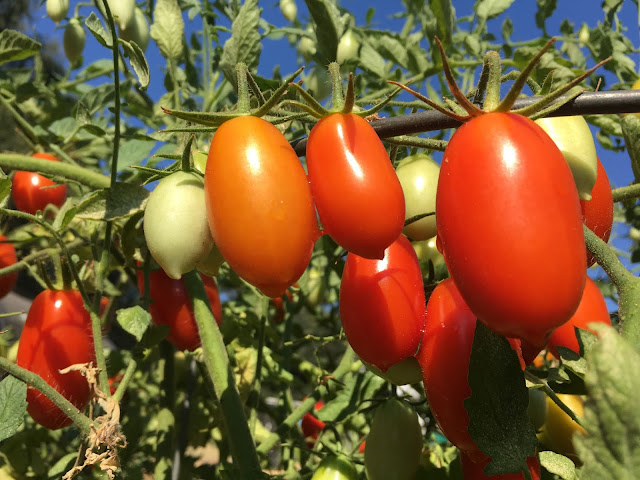
|
|
Juliet tomatoes pass the heat test in Sacramento's climate. (Photo: Kathy Morrison)
|
Plan for the climate when choosing tomato varieties
In these days of cold, fog and snow reports, it's easy to forget that we're going to be sweating through heat waves in just a few months.
Planning a tomato garden for such weather requires you to be equal parts soothsayer and scientist, with some meteorologist thrown in. Starting seeds now will give you a head start on the hot months -- a topic I wrote about
here
-- but you also should choose those varieties carefully.
After 23 years growing vegetables in the Sacramento climate, here's some things I learned about tomatoes and heat:
-- First, remember that extreme heat, over 100 degrees, will affect any tomato variety. Even the hardiest ones will slow down a bit or drop their flowers; these are survival techniques.
-- Dark tomatoes, such as Black Krim and Black Plum, are the most susceptible to heat. Many of them originated in colder climates, including Russia. They do have the most wonderful flavor, however, so if you plant them, give them the coolest spot in the tomato garden, preferably facing east, then be prepared for them to shut down during the hottest months. Last year my Black Plum came back to life in early fall and produced a great crop. You can read more about that
here
.
-- Hybrids tend to be hardier than heirlooms, which typically have thinner skin and burst easier in heat.
-- Cherry tomatoes can handle high temperatures better than full-size tomatoes. There are a few exceptions: I find the very popular Sun Gold splits much more than most cherries; I plant Sun Sugar for a gold cherry instead.
-- Choose indeterminate varieties over determinate ones, especially if they're touted as a "heat-tolerant" tomato. Determinate varieties bear all or most of their crop at once, while indeterminate ones keep producing, and usually will recover from a heat wave. Despite what I'd seen in previous years from such supposedly heat-hardy varieties, I tried Heatwave II hybrid, a determinate, last year. It whimpered in the face of the June heat waves and never really produced much.
Here are my choices for toughest tomatoes in the face of Sacramento heat:
1) Juliet, a hybrid large-grape tomato with wonderful flavor;
2) Big Beef, my go-to red hybrid for BLT-size slices, a classic;
3) First Prize, another excellent mid-size red tomato, an exclusive variety of Tomato Growers Supply Co.;
4) Lemon Boy, a yellow salad-size hybrid I've grown most years since I began starting seeds, the hardiest yellow tomato I've ever tried;
5) Sweet Chelsea, a large red cherry tomato that's quite a survivor.
The search for others goes on, of course, which is why I always try new varieties.

